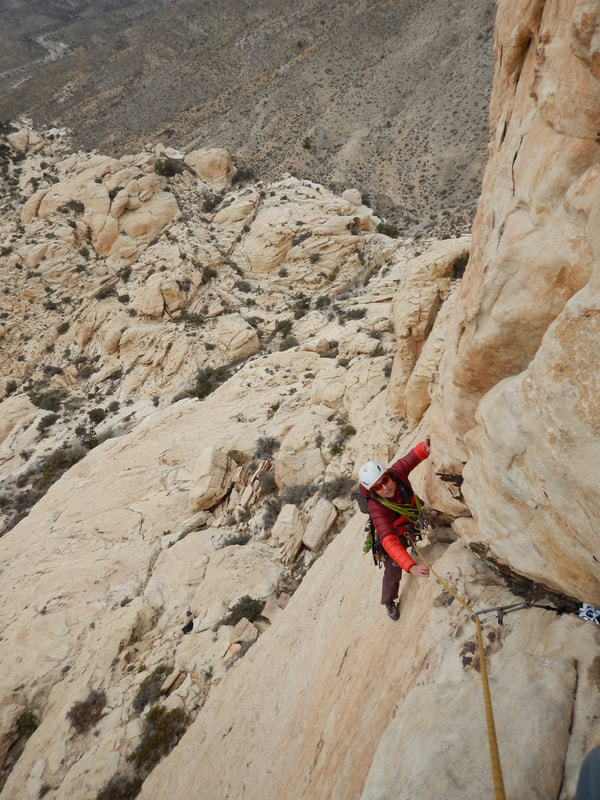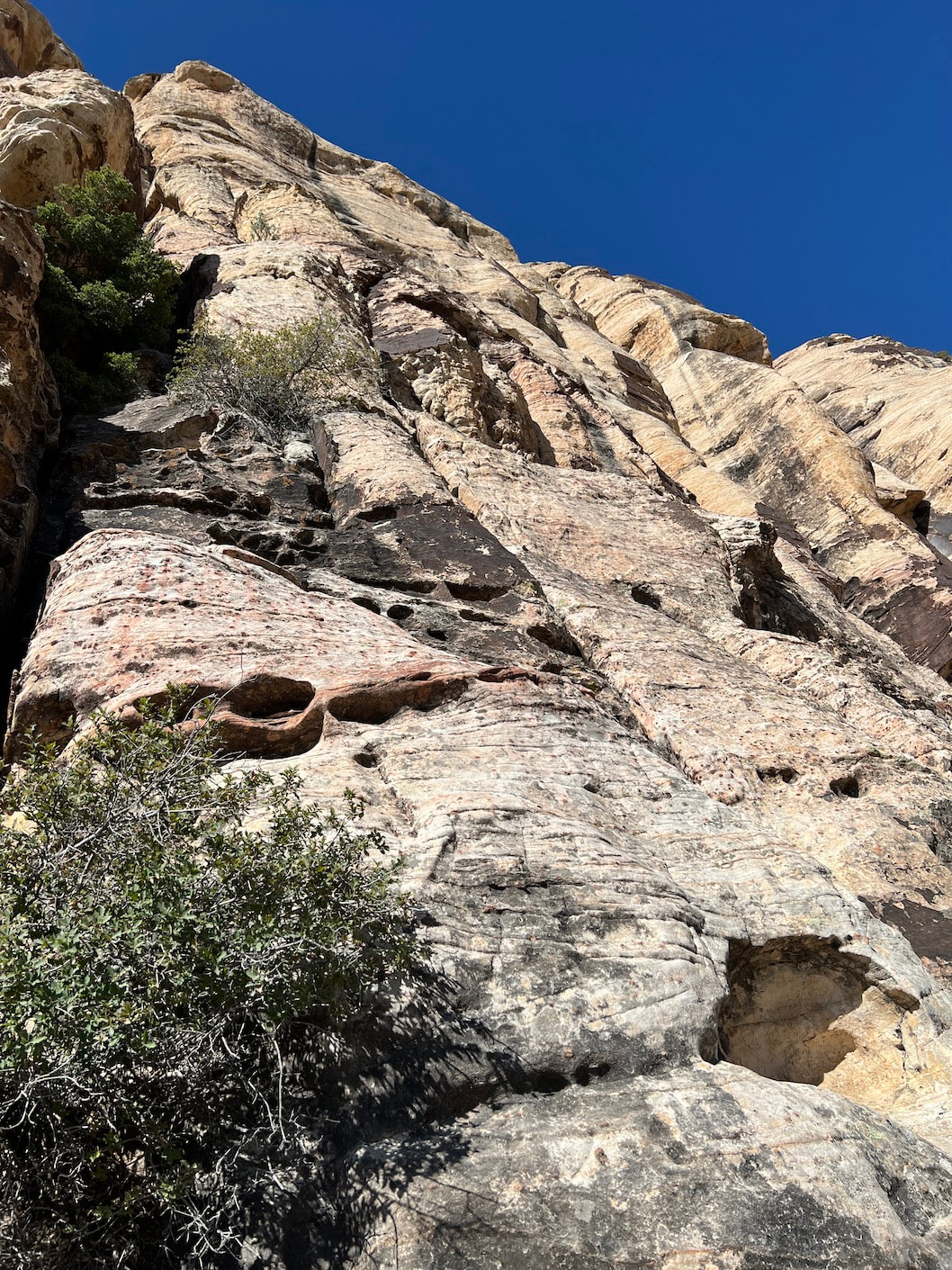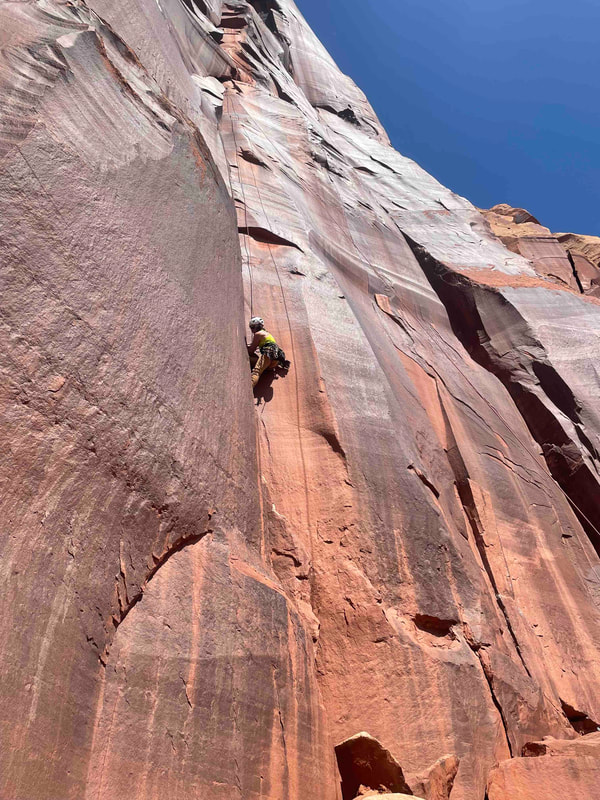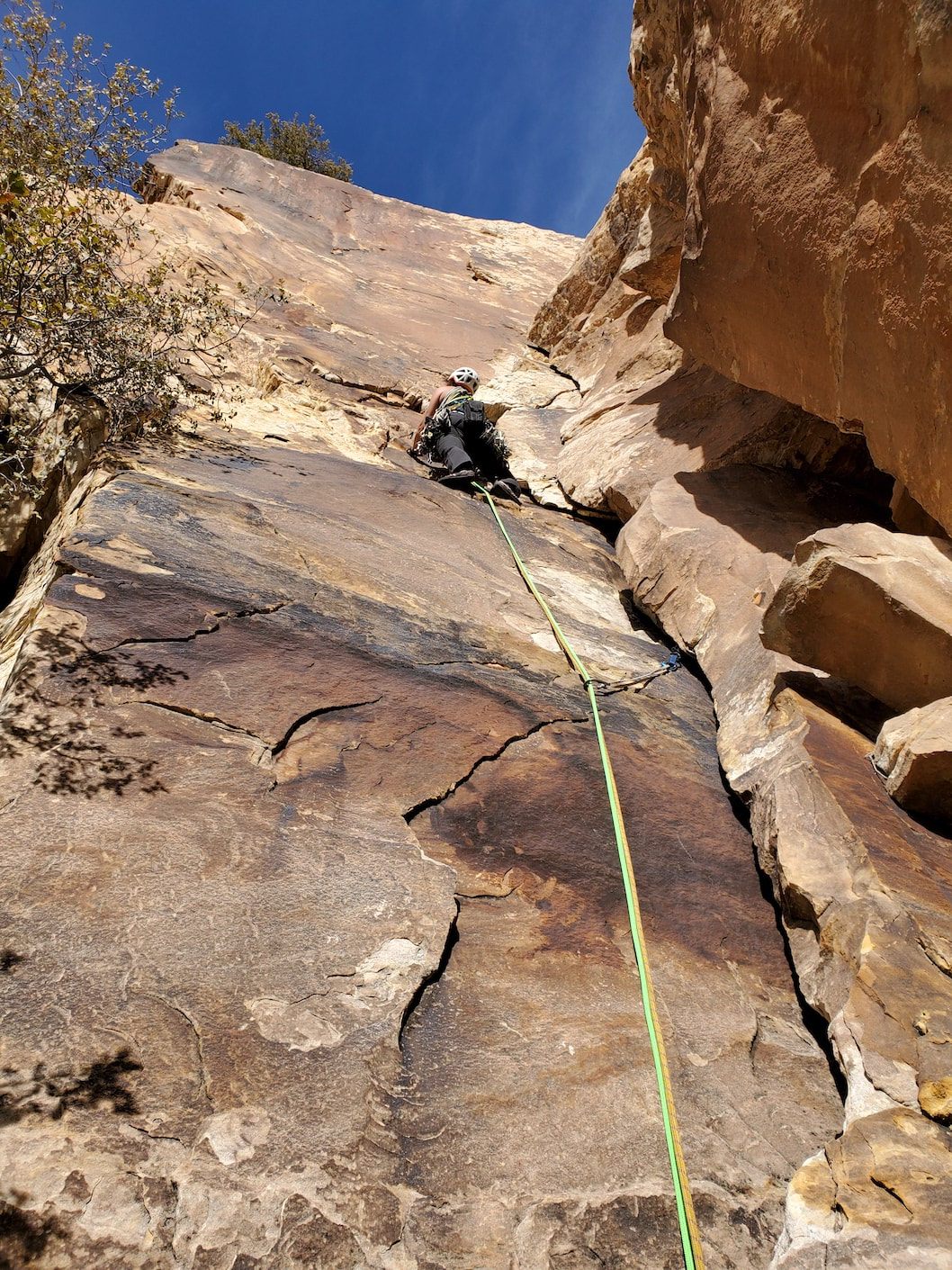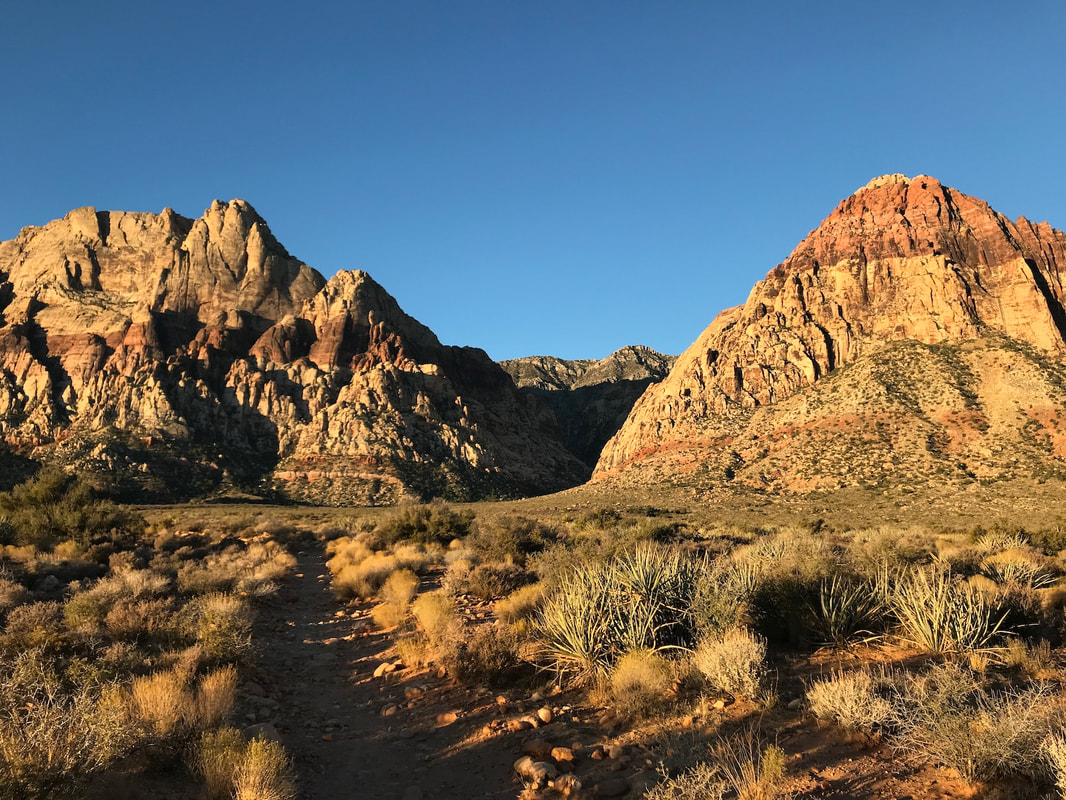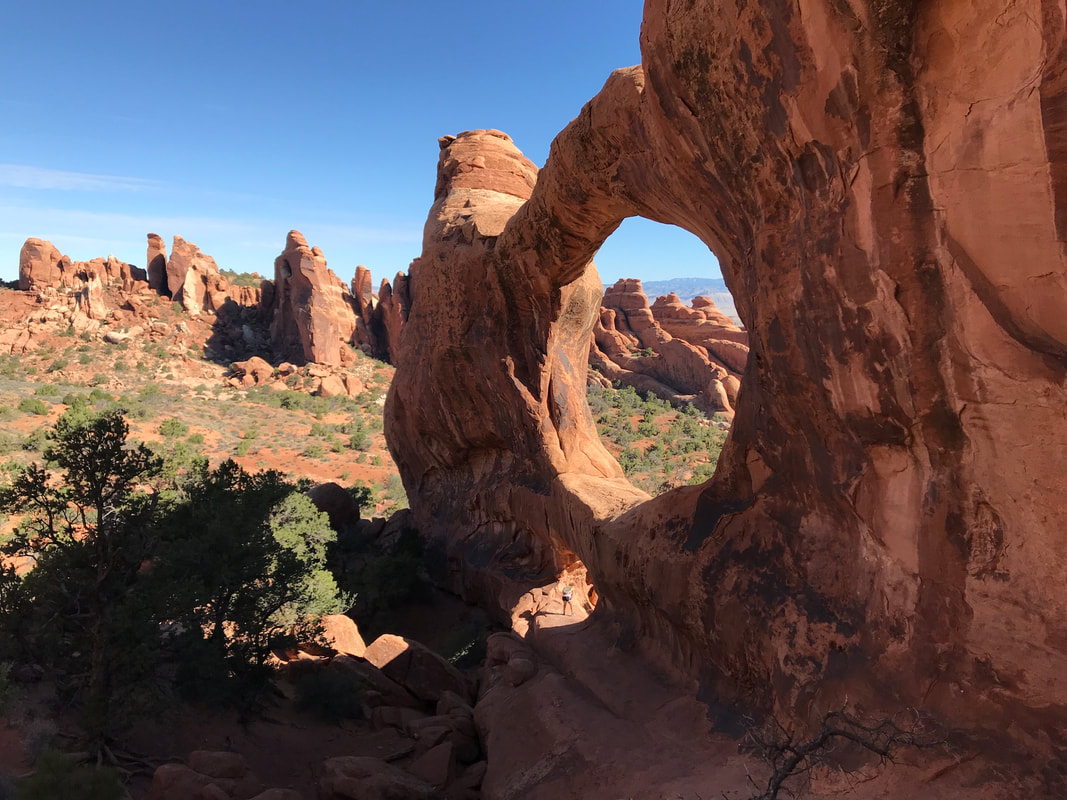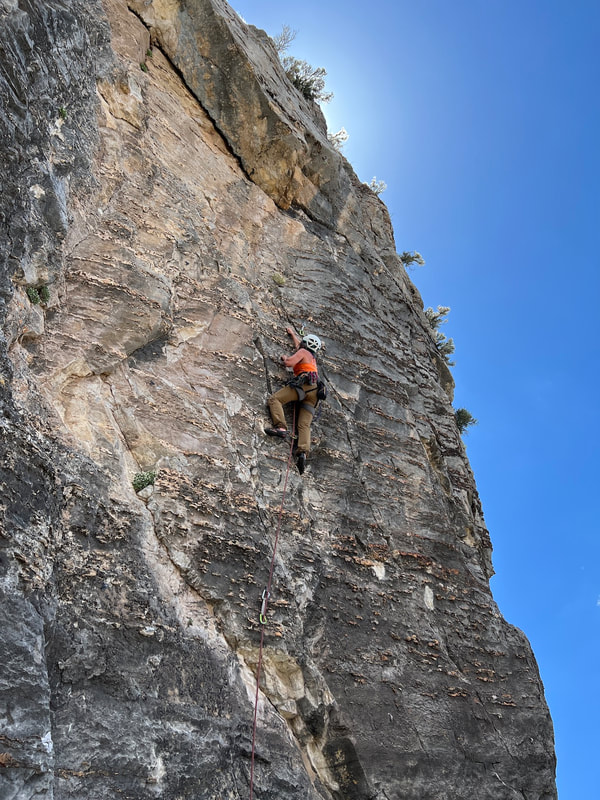Sandstone is the iconic bedrock of the desert Southwest. It molds towers and arches, canyons and peaks, spilling colors of pomegranate red, burnt orange, milky white, and even imposing black, against the bright sky. Each of the sculptures sandstone creates are invitations to be scaled, some by the extra daring.
Like any human attraction, there is no explaining sandstone’s allure. It houses some invisible, prime evil umbilical cord, drawing us to touch it and climb it.
The striking colors of sandstone not only catch our eyes from a distance and mesmerize us up close, those colors tell climbers of the rock’s true nature. I can look at the hue of the rock and (mostly) know what climbing it holds.
The orange-colored rock crumbles easily, like a scone. Protection is placed with extra care, crossed fingers, and a no-fall-attitude. Holds in this carrot-colored substrate are rounded and soft - shitty sand-covered slopers. If a crack exists, it is the most reliable feature - best to just keep your hands and feet inside.
The softness of the orange rock also means erosion into smooth slabs or pancake layers that separate and slide. On its face you seek subtle dips to place the balls of your feet and spread your hands across the gritty surface to maximize friction. Ass-out and heels down, it's a mental dance where you tell yourself the friction works, even though it feels as if you - and your skin if you fall - will peel off at any moment. It can be tempting to grab a tiny “hold” that teases you with its presence, but here you must resist temptation as it will disintegrate into dust during a desperate attempt to use it.
Like any human attraction, there is no explaining sandstone’s allure. It houses some invisible, prime evil umbilical cord, drawing us to touch it and climb it.
The striking colors of sandstone not only catch our eyes from a distance and mesmerize us up close, those colors tell climbers of the rock’s true nature. I can look at the hue of the rock and (mostly) know what climbing it holds.
The orange-colored rock crumbles easily, like a scone. Protection is placed with extra care, crossed fingers, and a no-fall-attitude. Holds in this carrot-colored substrate are rounded and soft - shitty sand-covered slopers. If a crack exists, it is the most reliable feature - best to just keep your hands and feet inside.
The softness of the orange rock also means erosion into smooth slabs or pancake layers that separate and slide. On its face you seek subtle dips to place the balls of your feet and spread your hands across the gritty surface to maximize friction. Ass-out and heels down, it's a mental dance where you tell yourself the friction works, even though it feels as if you - and your skin if you fall - will peel off at any moment. It can be tempting to grab a tiny “hold” that teases you with its presence, but here you must resist temptation as it will disintegrate into dust during a desperate attempt to use it.
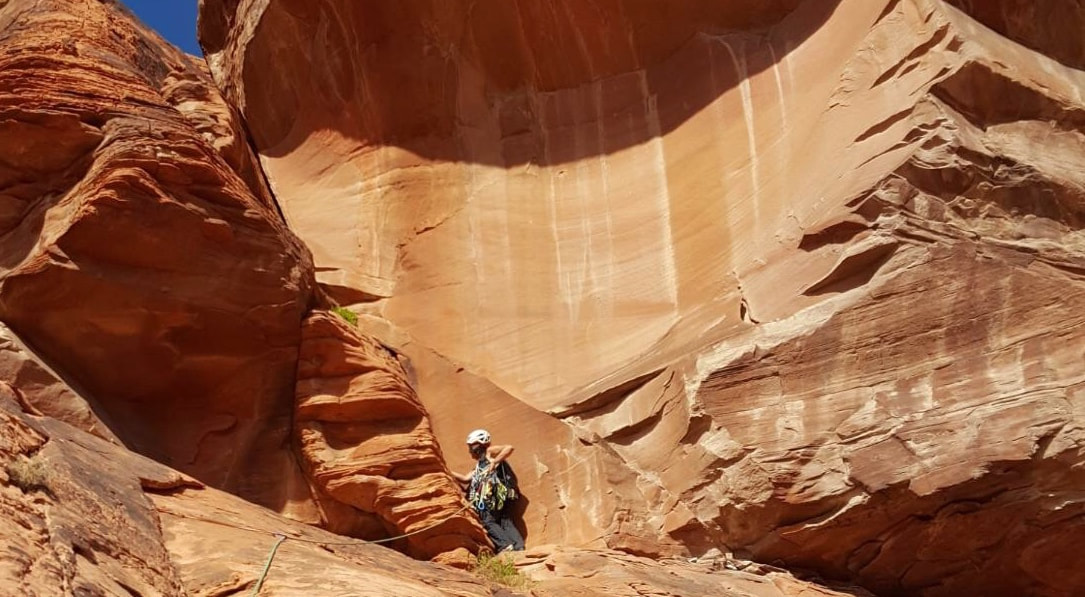
Author Stefani Dawn climbing on the crappy, soft, orange rock at Red Rock Canyon, Nevada. Although it looks cool, this climb, called "Lead and Languid" is quite possibly one of the worst climbs in Red Rock. See those characteristic "pancake layers?" those and any other holds were peeling off like spanikopita flakes. What's left of the climb was soft slab and that big wide crack above. (Photo Credit: Rick Momsen)
With the white rock, my blood pressure rises before I hop on - mostly because it offers fewer places for protection. I know the holds will be slopey and negative (a negative hold has a downward angle towards the climber, making it more difficult to grasp). Like the orange, the surface will be gritty, as though your feet are on a sea of microscopic ball bearings. What I don't know - until right upon it - is it the oh-shit scary white rock that crumbles? Or is it the thank-God-harder stuff with rounded divits and lips, where you can press the tips of two fingers to get a little more purchase?
When I see small black flecks and darker streaks amongst the white, I can exhale a little. Those flecks and streaks indicate a stronger binder with invisible bonds that reduce the crumble and allow tiny features to form upon the rock's erosion.
When I see small black flecks and darker streaks amongst the white, I can exhale a little. Those flecks and streaks indicate a stronger binder with invisible bonds that reduce the crumble and allow tiny features to form upon the rock's erosion.
My home crag is Red Rock Canyon. Despite the name, the rock here is not just red – it houses nearly every single color of sandstone in the repertoire – more than I have seen elsewhere (I’ve climbed sandstone in Moab and St. George, Utah, the New River Gorge on the East Coast, as well as, in the Blue Mountains of Australia.) Although all fantastic, none of these areas house the spectrum of sandstone that occur here.
Although much of the orange and red-colored rock in Utah, Arizona, Colorado, and Nevada may look similar, what you see was formed in very different geologic time periods under differing conditions – which also gives them distinct climbing experiences.
Indian Creek near Moab is known for big, long cracks that split otherwise featureless sandstone. The other direction from Moab are the infamous desert towers, which are little more than pillars of mud. And still yet, there are broad, slabby formations that dot the Southwestern landscape. Geologists give these various sandstone names- like Navajo, Entrada, Aztec, and Wingate.
Although much of the orange and red-colored rock in Utah, Arizona, Colorado, and Nevada may look similar, what you see was formed in very different geologic time periods under differing conditions – which also gives them distinct climbing experiences.
Indian Creek near Moab is known for big, long cracks that split otherwise featureless sandstone. The other direction from Moab are the infamous desert towers, which are little more than pillars of mud. And still yet, there are broad, slabby formations that dot the Southwestern landscape. Geologists give these various sandstone names- like Navajo, Entrada, Aztec, and Wingate.
The Red Rock Canyon sandstone is Aztec. It's the strongest of the desert Southwest "pure sandstone" bunch (although to those who only know climbing on hard granite or limestone, climbing at Red Rock can still feel remarkably fragile.) (NOTE: Quartzite is a form of "sandstone" that was under comparatively more pressure and heat, fusing the silica together, creating a much harder rock than any of the sandstones described here. In "pure sandstone" the silica still acts as a binding agent, but much of it is in round sand form, significantly weaking the bond.)
Even within the comparatively "strong" Aztec sandstone of Red Rock, there is variability of rock quality, often coordinating with the colors. In the stronger bed layers, silica/quartz is the primary binding agent holding the grains of sand together, while in the weaker white rock, calcium dominates. Other elements – like iron, manganese, carbon, sulfur –add to the personality mix.
The deep-red, iron-dominant Aztec sandstone is diverse in its climbing persona - weathering into ledges, edges, holes, pockets, flakes, chicken heads, and balls/knobs.
Even within the comparatively "strong" Aztec sandstone of Red Rock, there is variability of rock quality, often coordinating with the colors. In the stronger bed layers, silica/quartz is the primary binding agent holding the grains of sand together, while in the weaker white rock, calcium dominates. Other elements – like iron, manganese, carbon, sulfur –add to the personality mix.
The deep-red, iron-dominant Aztec sandstone is diverse in its climbing persona - weathering into ledges, edges, holes, pockets, flakes, chicken heads, and balls/knobs.
The iron-oxide balls/knobs are particularly cool. Here iron oxide precipitates around a grain of sand, building up while the softer material around it erodes. The result is round, protruding lumps (called moqui marbles) you can step on or pinch between your fingertips. One very popular climb in Red Rock is called Lotta Balls, commemorating a section of the climb laden with these iron oxide features.
ABOVE: Click photos to enlarge and see captions.
The deep, black walls are an irresistible call to climbers. Referred to as "desert varnish" or "petina," black walls offer offer their own “Hell yeah!” or “Oh, shit” effects. A smooth, shiny sheen means it’s “oh shit slick!" The slickness occurs because the black sandstone is comparatively hard. As water runs over the surface, it doesn’t erode or absorb as readily into the rock. Instead much of it washes over, polishing the rock to a sheen. On these polished climbs you pray for ledges, and edges, or cracks to reduce the slip and slide into an unwitting fall.
When the black rock is dull and matte-looking or broken into plates or chunks, it is the “hell-yeah” money-pitch. Here, water erodes sweet, diverse holds, sometimes shallow and crimpy, sometimes deep and juggy. And, the friction grips your feet firmly to the wall.
Most of the time grabbing onto a hold with black patina instills confidence that it won’t snap off - unless you see soft, orange rock beneath it.
When the black rock is dull and matte-looking or broken into plates or chunks, it is the “hell-yeah” money-pitch. Here, water erodes sweet, diverse holds, sometimes shallow and crimpy, sometimes deep and juggy. And, the friction grips your feet firmly to the wall.
Most of the time grabbing onto a hold with black patina instills confidence that it won’t snap off - unless you see soft, orange rock beneath it.
Of course, a single climb in Red Rock isn’t usually all red, white or black – it often has many colors, imbuing a joyful variety of climbing styles. That variety, in part, is what makes Red Rock Canyon so incredibly popular to climb, in addition to walls that reach 1000 feet or more into the air.
Combining elements - like magnesium, calcium, manganese, iron, sulfur, copper, carbon - into minerals is like an artist's palate - a little of this, a little of that, and stir. Pink to orange to purple to black, they emerge as magical combinations of our elemental earth. Add pressure and heat and we get the glues that bind the individual grains of sand together. Some glues are softer others are hard. As climbers we get to experience these works of art intimately - with our eyes, feet, hands, minds, and gear.
Even though the different colors and types of sandstone possess distinct personalities, there is one important characteristic of all desert sandstone – be it Aztec, Navajo, or Entrada - it absorbs water (East coast sandstone, like at the New River Gorge or Red River Gorge, is closer to quartzite and doesn't have the extra absorbent characteristics of desert sandstone). Even the slick black rock that sloughs off the rains has micro cracks that allow some water to infiltrate the hard, protective layer, thereby saturating softer rock below.
Water not only carves sandstone into the crazy, beautiful shapes we see, it invites sandstone to revert back to its original state – sand. As a result, the rock structure is weak after rain. Big chunks slough off. Climbing protection, like placing cams in a moist crack, have reduced grip. A hold, that otherwise might be bomber, easily snaps.
Combining elements - like magnesium, calcium, manganese, iron, sulfur, copper, carbon - into minerals is like an artist's palate - a little of this, a little of that, and stir. Pink to orange to purple to black, they emerge as magical combinations of our elemental earth. Add pressure and heat and we get the glues that bind the individual grains of sand together. Some glues are softer others are hard. As climbers we get to experience these works of art intimately - with our eyes, feet, hands, minds, and gear.
Even though the different colors and types of sandstone possess distinct personalities, there is one important characteristic of all desert sandstone – be it Aztec, Navajo, or Entrada - it absorbs water (East coast sandstone, like at the New River Gorge or Red River Gorge, is closer to quartzite and doesn't have the extra absorbent characteristics of desert sandstone). Even the slick black rock that sloughs off the rains has micro cracks that allow some water to infiltrate the hard, protective layer, thereby saturating softer rock below.
Water not only carves sandstone into the crazy, beautiful shapes we see, it invites sandstone to revert back to its original state – sand. As a result, the rock structure is weak after rain. Big chunks slough off. Climbing protection, like placing cams in a moist crack, have reduced grip. A hold, that otherwise might be bomber, easily snaps.
In short, wet sandstone in the desert Southwest becomes dangerous to a climber – and we become dangerous to it. For these reasons, locals - and those who pay attention and care - don’t climb the sandstone for at least 24 hours after rain - more after a heavy saturation.
I witnessed an unfortunate rescue of a visiting climber who chose to ignore that there were three days of heavy rains before the sunny day he hopped onto the rock. Although I had certainly wanted to climb on my weekend day, I went for a hike instead and witnessed the search and rescue crew removing a several-hundred-pound block that crushed the climber's hip and leg. His partner had climbed that same over-hung sport route just moments before.
I witnessed an unfortunate rescue of a visiting climber who chose to ignore that there were three days of heavy rains before the sunny day he hopped onto the rock. Although I had certainly wanted to climb on my weekend day, I went for a hike instead and witnessed the search and rescue crew removing a several-hundred-pound block that crushed the climber's hip and leg. His partner had climbed that same over-hung sport route just moments before.
|
Naturally not all damage from climbing the desert's wet sandstone results in injuries to the climber - but it can forever change the routes themselves. Often when we hop on a climb that is far harder than the original grade given, you can see where holds once were.
It is understandable when people spend time and money coming to a world-class climbing destination like Red Rock Canyon and they want to climb - even if it rains. It's hard to resist the lure of the incredible rainbow rock on a sunny day after a big rain. It's torture to think you won't get to tell your own story of sending the classics. Even I, as a local, get REALLY bummed when the rain-cycle hits on the weekends (which has been happening a lot these past few years) - as weekends are my only days available to climb. I, too, have long list of climbing objectives here at Red Rock! But little do people know, that the Las Vegas valley has two other types of rock that don't give a shit about the rain - limestone and granite. In fact, there is so much limestone here that a new(ish) book called Mojave Limestone (published in 2021) features 2,500 climbs - including sport multipitch. Las Vegas limestone, a predominately grey-colored substrate comprised of calcium carbonate excreted from corals and microscopic animals beneath a very ancient sea, is a whole other geology and climbing story of sharp holds, chert intrusions, and friction galore! |

